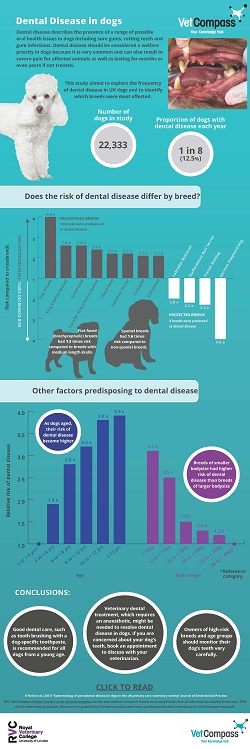Epidemiology of Canine Periodontal Disease
Clinical Connections – Autumn 2021
Dan O’Neill, Senior Lecturer in Companion Animal Epidemiology
Periodontal disease describes the most common form of dental disease in dogs, spanning a spectrum from inflamed gums to deeper infections that can ultimately lead to tooth loosening and loss. As well as direct oral effects, periodontal disease can promote infections in organs such as the kidneys, heart and liver. One in eight of all dogs seen each year in first opinion veterinary care are diagnosed with periodontal disease.
Dogs often endure pain so bravely and quietly that many owners are unaware of their suffering from periodontal disease. Consequently, first opinion veterinary teams are crucial in getting owners to understand not just dental disease risks and consequences but also promoting an awareness of ‘lived experience’ for affected dogs.

Veterinarians are well aware of typical signs of dental disease in dogs, including discoloured teeth, bad breath, inflamed gums, loose teeth, excessive drooling, blood on chew toys and reluctance to chew. However, many owners might not notice these problems at all, or may just write them off as normal ageing or normal for their dogs. These delays in seeking veterinary care mean that dogs endure unnecessary pain from dental problems that have advanced to stages where successful intervention is more difficult. A key step needed to resolve these issues is getting good evidence on the frequency of dental problems, and which dogs are most likely affected. This information can help veterinary professionals to prioritise our efforts on canine dental care and communicate proactively with owners to avoid more advanced problems.
A recent study from the VetCompass Research Team at the RVC sought to document for the profession just how common periodontal disease in dogs is. As with other studies, VetCompass collected anonymised clinical information from first opinion veterinary practices in the UK and examined the data for the benefit of dogs and their owners and to help our veterinary colleagues address risks and problems with owners.
What did VetCompass discover?
Firstly, how common is periodontal disease in dogs? From a random sample of 22,333 dogs attending 784 UK veterinary clinics, the VetCompass study identified that 2,797 dogs (12.5%) were diagnosed with periodontal disease in a single year. In fact, periodontal disease was by far the most commonly diagnosed disorder in UK dogs, with ear infections (7.3%) and obesity (7.1%) coming in a distant second and third. This horror story of one in every eight UK dogs suffering from periodontal disease highlights the hidden dental epidemic that our dogs are enduring so bravely.
Are certain types of dogs more likely to be affected by periodontal disease, and if so, can we use this information to improve detection? The results showed that certain breeds were phenomenally predisposed, with the greyhound (32.21% affected) King Charles spaniel (30.14% affected), toy poodle (25.97% affected), Cavalier King Charles spaniel (25.29% affected) Yorkshire terrier (22.22% affected) and Border terrier (22.09% affected) topping the list. Owners of breeds that are highly predisposed to periodontal disease should be encouraged by veterinary professionals to be especially alert to signs of poor oral health. Veterinarians check and should comment explicitly on the dog’s teeth on each visit as a matter of course to underline the importance of dental health to owners.
What other useful predictors of periodontal disease in dogs were discovered in the study? Periodontal disease is a progressive disease that worsens as dogs age. The study showed that dogs aged eight years and above were over three times more likely to be affected with periodontal disease compared with young adult dogs aged two to four years. As a general rule, smaller-sized dogs were more prone to periodontal disease than larger dogs: dogs weighing under 15kg were 2.5 times more likely to be affected than dogs weighing 30-40kg.
And interestingly, insured dogs were 30% more likely to be diagnosed than uninsured dogs, highlighting that increasing levels of care provided by owners and veterinarians can remarkably increase detection rates of periodontal disease, reduce unnecessary suffering and deal with conditions earlier.
